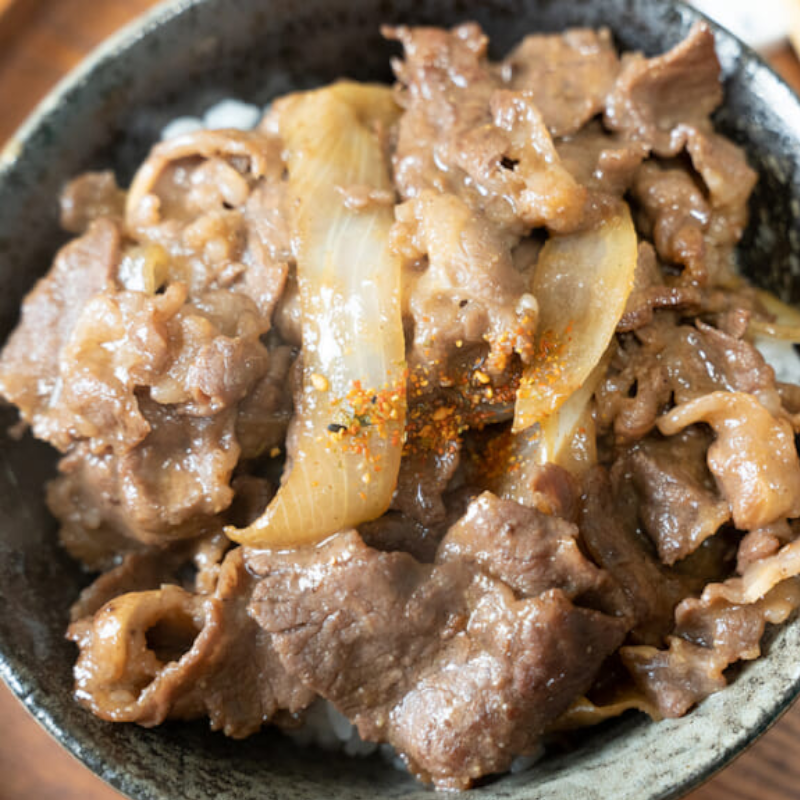Donburi Gyudon (牛丼) - Japanese Rice Bowl with Beef
 Garanties sécurité
Garanties sécurité
(à modifier dans le module "Réassurance")
 Politique de livraison
Politique de livraison
(à modifier dans le module "Réassurance")
 Politique retours
Politique retours
(à modifier dans le module "Réassurance")
The Origin, History, and Technique of Donburi Gyudon (牛丼) - Japanese Beef Rice Bowl
Gyudon (牛丼), literally meaning "beef bowl" in Japanese, is an iconic dish in Japanese cuisine, particularly appreciated for its simplicity and savory taste. This dish consists of a bowl of rice topped with thin slices of beef, cooked in a savory broth made from soy sauce, mirin, sake, and dashi. This blend creates a rich and sweet sauce that coats the beef and melds perfectly with the rice.
Origin and History of Gyudon
Gyudon appeared in the late 19th century during the Meiji era (1868-1912). At this time, Japan opened its doors to the outside world after a long period of isolation, and new culinary influences began to infiltrate Japanese cuisine. Ingredients like beef, which was previously rarely consumed in Japan, became more common. Gyudon, a relatively simple and affordable dish, was influenced by Western cooking methods, particularly stew techniques.
Legend has it that Gyudon was popularized by a restaurant in Tokyo, named Yoshinoya, founded in 1899. This restaurant began selling rice bowls topped with beef cooked in a light soy and sugar-based broth, quickly becoming a favorite meal among Japanese workers for its speed and affordability.
Gyudon gained immense popularity in the 1950s and 1960s, when restaurant chains like Matsuya and Sukiya opened establishments offering this dish as Japanese fast food. Today, Gyudon is one of the most consumed dishes in Japan, thanks to its convenience and affordability.
The Technique of Preparing Gyudon
Gyudon is a relatively simple dish to prepare but requires specific techniques to ensure the beef stays tender and the sauce infuses properly. The key to success lies in using very thin slices of beef, which allow for quick cooking without losing tenderness. The broth in which the ingredients cook must also be carefully prepared to create a flavorful and balanced sauce.
Main Ingredients:
- Rice: Japanese rice (usually short-grain white rice) is the base. It is cooked and served in a bowl, then topped with beef and sauce.
- Thinly sliced beef: Use very thin slices of beef, preferably from tender cuts like sirloin or shank, which remain tender after cooking. These slices allow the beef to cook quickly in the broth.
- Sliced onions: Onions add sweetness and depth of flavor to the dish.
- Dashi (Japanese broth): Dashi is a light broth made from kombu (seaweed) and bonito (dried fish flakes). It forms the base of the gyudon sauce.
- Sake and Mirin: Sake (Japanese rice wine) and mirin (sweet rice wine) add slightly sweet notes and depth to the broth.
- Soy sauce: Used for seasoning, it adds saltiness and umami to the dish.
- Sugar: A little sugar is used to sweeten the mix and balance the salty flavors of soy sauce and dashi.
Garnishes:
- Green onions: Finely chopped, they are used to garnish the dish before serving. They add freshness and a slight kick.
- Shichimi Togarashi: A blend of seven Japanese spices, often sprinkled on gyudon before serving to add heat and additional aroma. The seven main spices are:
- Red chili pepper
- Tangerine zest
- Sesame seeds
- Poppy seeds
- Hemp seeds
- Nori or Aonori (powdered seaweed)
- Sanshō (Japanese Sichuan pepper)
Preparation of Gyudon:
- Cooking the rice: The rice should be cooked perfectly so that its texture is firm and sticky, allowing it to absorb the broth while maintaining its structure.
- Cooking the beef and broth:
- In a pot, prepare the dashi. Add sake, mirin, soy sauce, and sugar to create a sweet and salty broth.
- Add the beef slices and sliced onions to the broth. Let it simmer for a few minutes until the beef is cooked through.
- Assembling: Serve the hot rice in a bowl, then add the beef slices and onions in the sauce. Garnish with some chopped green onions and, if desired, sprinkle with shichimi togarashi for a spicy kick.
Conclusion
Gyudon is a dish deeply rooted in Japanese tradition, combining simplicity, speed, and rich flavors. From its humble origins in local Tokyo restaurants in the early 20th century, it has become one of the most popular and beloved dishes in Japan, offering a delicious and filling meal in record time. Whether for a quick lunch or a hearty dinner, Gyudon remains a true icon of Japanese cuisine.


